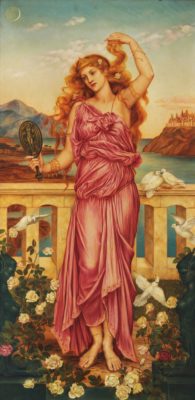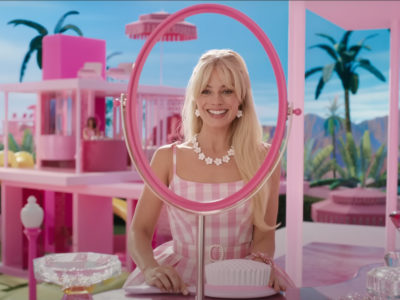What would the De Morgans make of life in 2023?
When the ‘Barbie’ movie came out, I posted a picture of Helen of Troy (1898) by Evelyn De Morgan on Facebook. I thought it was a bit of fun because, let’s face it, Helen does look a bit like Barbie. Along with the picture, I posted a caption asking who was excited about the film. A follower commented something about me jumping on the bandwagon and what did this film have to do with Victorian art? At the time, I thought that was fair enough, I was just getting excited about everyone posting pictures in their pink outfits and wanted to join in. It’s been a while, but I have now joined the rest of the world and finally seen the film. Having done so, I am compelled to write a full blog post which absolutely defends my decision to align Helen of Troy (1898) with the Barbie Movie (2023). As we will see, Helen and Barbie represent so much more that beautiful women with a pink dress and blonde hair.

Helen of Troy (1898) by Evelyn De Morgan
The Barbie Movie starts out much how I had anticipated. Barbie and her pals living in their pink dream world where girls rule. Perfect smiles, high heels, manicures and slumber parties. For the central character of Stereotypical Barbie (played by Margot Robbie), this begin going awry when she develops thoughts of death and cellulite. This is signal that all is not well in the real world; whoever is playing with the Barbie toy she represents in this parallel universe is clearly unhappy. There is only one solution, Barbie must travel to LA, find her person, and restore her happiness. Oh, and Ken follows her. Barbie is shocked by the real world where the patriarchy rules, she had been led to believe that the invention of Barbie had awoken women and inspired them to rise above and take charge. What follows is Barbie’s existential crisis where she contemplates the role of gender, beauty, inequality, and power, and ultimately her role within this complex social matrix. Director Greta Gerwig has used an established female icon of popular culture to question the values of that culture.

Margot Robbie as Barbie (2023)
I came away from the film contemplating these issues, but also found it difficult to shake this idea: what if we consider Barbie land as the De Morgans’ Victorian London and imagine this artistic couple as Barbie and Ken travelling to 2023? Would they be shocked and disappointed? Evelyn’s trailblazing art education at the Slade School of Art, where she succeeded to award-winning student over her male colleagues, and regularly exhibited at the Grosvenor Gallery with more famous men, had not really solved the problem of the representation of female artists in popular culture today? According to the Freelands Foundation’s “Representation of Female Artists in Britain” 2019 report, 28 of London’s major commercial galleries were 68% male in 2018, with female artists and their estates making up just 32% of the artists represented. It’s a similar story in popular music. In 2022, 30% of artists on the Billboard Hot 100 Year-End Chart were women, which was an improvement over 2021’s 23.3% but it’s still far from equal. William De Morgan was an ally for the suffragettes, campaigning for women to have the vote. What would he make of the world today? I can’t speak for him but I am certain he’d be annoyed a how little progress towards true equality has been achieved in over a century since his campaign.
In 1898 when she painted Helen, Evelyn De Morgan was at the height of her success, exhibiting and selling her paintings and receiving positive reviews in the press. But it was a man’s world and she was constantly working to establish her place in it. At this time, she turned to mythological tales and chose to illuminate the seldom-told stories of central female characters such as Helen of Troy. Born to the gods Zeus and Leda, Helen’s life was marked by her unparalleled beauty, a blessing and curse that shaped her destiny. She found herself in a loveless marriage to King Menelaus of Sparta, a union orchestrated by politics and power. When Paris, a Trojan prince, arrived in Sparta and kidnapped Helen, war was declared by Menelaus and his brother Agamemnon. The Trojan Wars, as these decade-long battles became known, were some of the most brutal in mythology. Helen was innocent in the wars, and yet they were caused by her beauty, just how it was the curse of her beauty that caused her unhappy marriage and terrifying abduction. She was objectified and her agency removed. In the Barbie movie, this is something that shocks Barbie more than any other facet of modern life. As she rollerblades along Venice Beach, a passer-by slaps her bum. Complain as she might to the police officer who arrests her, this abuse is overlooked as all too common, acceptable behaviour. In a society that values beauty, sets the standard of what that means, and punishes anyone without it, victims are also those women who are believed to possess it and are objectified for it. And sadly, it is a tale as old as time. Well, at least as old as the 4000 year old myth that De Morgan and Gerwig both highlighted in their respective art forms.
“Barbie as an idea, as a brand, had this mission statement of inspiring girls to be whatever they wanted to be as adult women,” said Greta Gerwig, the Barbie Movie director. ”And then I think it’s very important to have an adult woman talk about all of the kind of impossible contradictions.” Evelyn De Morgan must have felt similar contradictions. Her family expected her to adhere to the norms of high society and marry high-ranking nobleman, but instead she became a bohemian and an artist. Even then she wasn’t fully accepted as the art world in Victorian London was a patriarchal one. Perhaps she saw such contradictions in the story of Helen; a woman blamed for the power and danger of her beauty, when such beauty is merely a social construct.
The Barbie movie is a brilliant account of being a woman in the 21st century and has been a useful tool in reassessing De Morgan’s painting of Helen of Troy through a contemporary lens. Oh, and it’s fab. You must go and see it if you haven’t already!
Sarah Hardy
Director of the De Morgan Foundation





